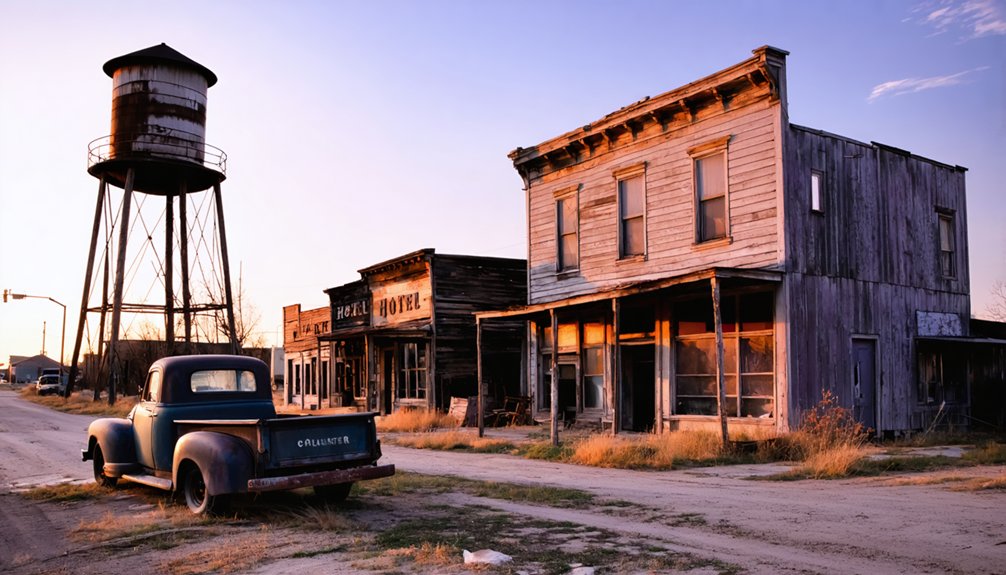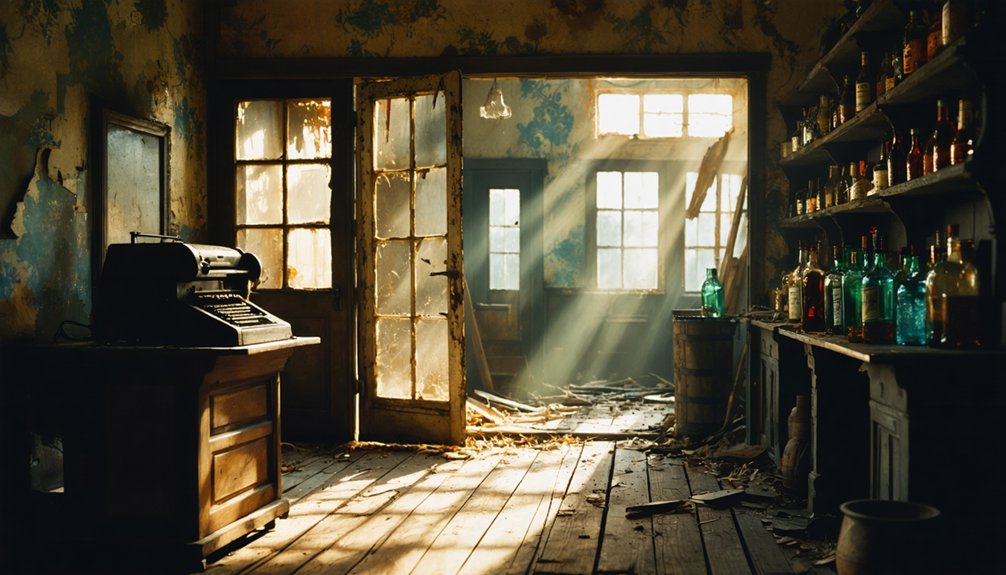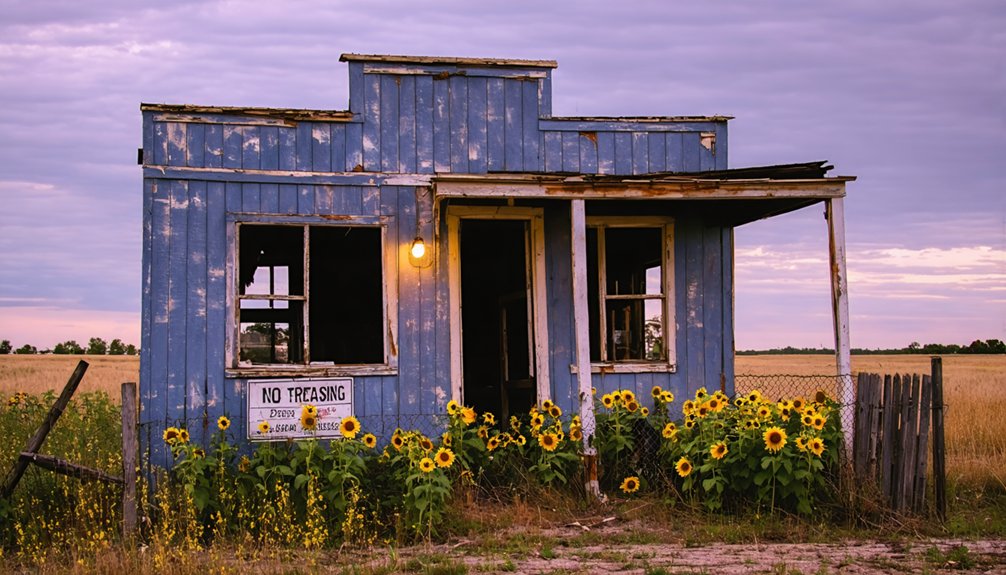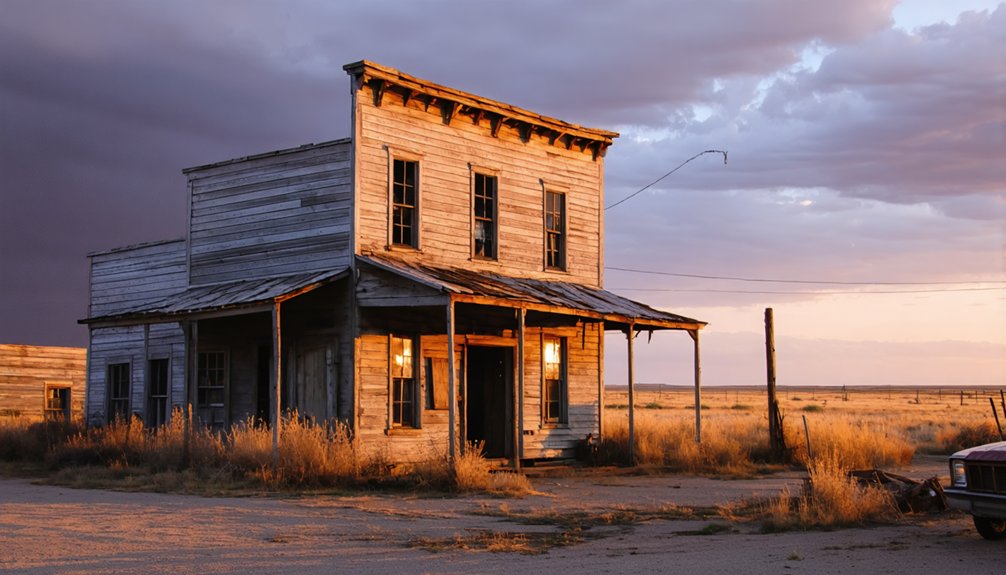You’ll find Twilight among South Dakota’s most mysterious ghost towns, with its exact location now lost to time. The settlement emerged in the 1880s during the region’s railroad expansion and briefly flourished as an agricultural hub. Like many prairie towns, Twilight fell victim to changing economic conditions, farm consolidation, and the Great Depression. While the town’s structures remain on private property requiring explicit permission to visit, its fascinating story mirrors the rise and fall of countless Black Hills communities.
Key Takeaways
- Twilight is an abandoned settlement in southwestern South Dakota that declined due to water supply problems and economic challenges.
- The town followed a T-shaped layout with the railroad as one axis and Main Street perpendicular to it.
- Access to Twilight requires explicit permission from property owners as the structures are located on private land.
- The town’s decline began with mineral depletion and agricultural market struggles between 1878-1887, accelerated by the Great Depression.
- Twilight’s exact location remains uncertain, with only fragmentary historical records hinting at its possible whereabouts.
The Search for a Forgotten Settlement
When you venture into southwestern South Dakota’s rolling prairies in search of Twilight, you’ll find yourself traversing through a landscape dotted with abandoned settlements. Like many South Dakota ghost towns, Twilight’s remnants reflect the region’s historical settlement patterns and economic activities. The town’s remote location presents challenges, but you’ll discover hints of its past near old water sources and former railroad lines that once brought life to this ghostly outpost. Similar to Ardmore’s fate, the town declined after facing water supply problems.
While exploring, you’ll encounter fenced-off structures in various states of decay – from crumbling homes to weather-worn commercial buildings that whisper settlement stories of an earlier era. As you navigate the remnants of this prairie town, you’ll notice nature’s gradual reclamation of human-built structures, with vegetation creeping through abandoned foundations and weathered walls.
Though access may be limited by “no trespassing” signs, you can still glimpse Twilight’s historical significance from designated viewing points.
Historical Records and Documentation
If you’re researching Twilight’s history through archival records, you’ll find fragmentary evidence in county deed registries, tax assessments, and postal records spanning the early settlement period.
Local newspaper coverage from neighboring towns occasionally mentioned Twilight in their regional reports, though these references became increasingly sparse as the settlement declined.
The South Dakota State Historical Society‘s archives contain several maps and photographs that help piece together Twilight’s brief existence, including documentation of property transfers and eventual abandonments. One notable local publication, the Kappa Hustler newspaper, provided regular coverage of community events and developments during the town’s peak years.
Archival Records Search Findings
Though archival records of Twilight remain scarce, the South Dakota State Historical Society maintains several key documents that shed light on this vanished mining town.
Recent investigations by a haunted house photographer provide additional documentation of the town’s abandoned structures, though his photographic evidence remains controversial.
If you’re researching Twilight’s archival significance, you’ll find that most records focus on its mining operations and eventual abandonment, though many details have been lost to time.
The ghost town dynamics of Twilight follow a familiar pattern you’ll recognize in South Dakota’s history – a post office designation, a period of mining activity, and an eventual decline that left no physical traces.
Like many of the six hundred ghost towns that once dotted the Black Hills region, Twilight’s story represents unfulfilled ambitions and lost populations.
Through the state’s historical archives and local libraries, you can access what limited documentation exists, though you’ll need to piece together Twilight’s story from incomplete records and broader regional histories.
Newspaper Coverage Analysis
The complete absence of direct newspaper coverage for Twilight, South Dakota presents a significant challenge in documenting this ghost town’s history.
You’ll find no mention of Twilight in major newspaper archives, which mirrors the fate of many South Dakota settlements that vanished without significant press attention.
Like other abandoned communities documented in Chris Attrell’s video explorations, if Twilight existed, its story would’ve likely appeared in local weeklies like the Rapid City Journal or Black Hills Pioneer, following typical ghost town narratives: reports of business closures, school consolidations, and departing residents.
Some ghost towns were so completely erased that all signs of life have disappeared, leaving the landscape barren and empty.
Digital archives show substantial gaps in rural South Dakota coverage from the late 1800s through early 1900s.
County seat papers, such as the Hot Springs Star and Edgemont Tribune, might hold uncatalogued references, but name confusion and incomplete digitization make verification difficult.
Geographic Mystery and Location Theories
Despite extensive research efforts by historians and ghost town enthusiasts, Twilight’s precise location in South Dakota remains one of the state’s most perplexing geographic mysteries.
Like many ghost town legends, Twilight’s coordinates have been lost to time, with only fragmentary records hinting at its possible whereabouts. Similar to the desolate Capa that’s only accessible by nine miles of gravel, you’ll find varying theories about its location, from speculation about railroad-adjacent sites to potential farming settlements now hidden beneath private land.
While geographic folklore places it roughly 25 miles from known landmarks, the absence of surviving structures or reliable maps makes verification impossible. The fate of many South Dakota towns was sealed when three major fires devastated their buildings and infrastructure, as seen in Cottonwood’s history between 1913 and 1938.
Unlike better-documented ghost towns like Capa and Cottonwood, which still maintain visible ruins, Twilight has seemingly vanished into the South Dakota landscape, its exact position remaining tantalizingly out of reach.
Local Legends and Community Memory
Legends of Twilight live on through generations of South Dakota families, passed down like cherished heirlooms at dinner tables and community gatherings.
Like many ghost towns from the late 1800s, Twilight’s story has become deeply woven into local folklore, shaping the region’s community identity long after its abandonment.
You’ll hear tales from descendants of early settlers who recall their grandparents’ stories about Twilight’s transformation from a bustling railroad stop to a defunct settlement.
While some details may have blurred with time, these oral histories preserve essential elements of South Dakota’s development during the railroad and mining era.
The town’s legacy, much like other abandoned communities across the state, serves as a reminder of how economic shifts and infrastructure changes can dramatically alter a town’s destiny.
Travelers exploring these forgotten places must exercise caution and show respect for private property when visiting the scattered remnants of South Dakota’s past.
Comparing Similar Ghost Towns

When you look at Twilight’s development patterns, you’ll notice striking similarities to other South Dakota ghost towns like Spokane and Capa, which all experienced brief population peaks around 1900 tied to specific economic drivers.
Like many Black Hills settlements, Twilight shares common features with mining towns that established post offices in the 1880s as anchors for their small but bustling communities.
You can trace parallel decline patterns between Twilight and railroad-dependent towns like Okaton and Cottonwood, where the loss of rail service and primary industry led to rapid abandonment of buildings and eventual ghost town status.
Abandoned Railroad Town Patterns
Three distinct patterns characterize South Dakota’s abandoned railroad towns, with Twilight following the most common layout: a T-shaped configuration where the railroad formed one axis and Main Street ran perpendicular, terminating at the depot.
You’ll notice this railroad influence reflected in how the commercial district clustered near the tracks, maximizing access to freight and passenger services.
- Town layout focused on efficient land sales, with standardized street patterns every 5-10 miles along the rail line
- Strategic placement of grain elevators and warehouses along sidings made shipping agricultural products seamless
- Railroad companies deliberately planned these configurations to optimize profitability while serving local farmers
Like many similar ghost towns, Twilight’s design prioritized railroad accessibility above all else, with streets and buildings oriented to support the rail-based economy that once drove the region’s growth.
Mining Settlement Common Features
Unlike Twilight’s railroad-centric layout, mining settlements across South Dakota’s Black Hills shared distinct features that you’ll recognize in numerous ghost towns today.
You’ll spot remnants of essential mining infrastructure like mine shafts, ore bins, and large processing mills dotting the hillsides. As these communities grew, they developed beyond mere mining operations, establishing schools, post offices, and stores to serve their growing populations.
The harsh life of miners and their families shaped community dynamics, with workers battling severe weather and underground dangers while embracing unique mining superstitions.
Look for telltale environmental markers of these settlements: cyanide vat remnants, towering tailings piles, and eroded mine waste areas that still scar the mountainous terrain, often positioned strategically near historic railroad routes.
Prairie Development Site Traits
While mining settlements carved their presence into the Black Hills, prairie ghost towns like Twilight tell a different story across South Dakota’s vast plains.
You’ll find these prairie characteristics defined by their strategic placement along historic rail lines, where towns sprouted up as crucial agricultural hubs. The ghost town traits reflect the region’s boom-and-bust cycle, with abandoned grain elevators standing as silent sentinels against the horizon.
- Original development focused on railroad accessibility, with communities growing around fundamental train stops
- Geographic isolation places these sites far from modern highways, preserving their authentic remnants
- Natural prairie elements gradually reclaim the landscape, with wind-swept grasses weaving through deteriorating structures
These settlements now merge back into the plains, where expansive views and dramatic sunsets create an ethereal backdrop to their weathered remains.
Architectural Remains and Physical Evidence

Physical evidence of Twilight’s architectural remains presents a significant challenge to document, as no up-to-date photographic or video documentation exists.
Modern documentation of Twilight’s physical structures remains elusive, with no current photographs or video records to verify their existence.
Like many South Dakota ghost towns, you’ll likely find the site has reverted to prairie, with few traces of its former structures. The architectural significance may be limited to foundations or footings, if they’ve survived at all.
While similar ghost towns in the region used local timber, brick, and fieldstone construction, Twilight’s archaeological potential remains largely unexplored.
Without recent surveys or preservation studies, you can only compare it to nearby abandoned settlements like Capa or Cottonwood, where harsh Dakota winters and neglect have reduced most buildings to ruins.
The site’s current condition suggests it falls into the “barren” category of ghost towns, where civilization’s footprint has nearly vanished.
Economic Factors and Town Abandonment
Like many South Dakota ghost towns, you’ll find that Twilight’s economic collapse stemmed from its heavy reliance on railroad connections and mining operations that proved unsustainable by the mid-20th century.
You can trace the town’s initial decline to the mineral extraction slowdown, which left Twilight without its primary economic driver and triggered a cascade of business closures.
The final blow came when struggling agricultural markets couldn’t support the remaining population, forcing families to abandon their properties and seek opportunities elsewhere.
Railroad Access Impact
As South Dakota’s railroad companies expanded their networks in the late 1800s, they transformed Twilight from empty prairie into a bustling agricultural hub. The railroad’s significance sparked an economic transformation that would define the town’s rise and eventual fall.
You’d have found grain elevators, warehouses, and merchant shops clustered around the depot, where locals shipped their harvests and received essential supplies.
- Rail access connected you to major markets, making farming and commerce profitable in ways previously impossible.
- The depot served as your gateway to the wider world, bringing mail, telegrams, and passenger service.
- You could find steady work in railroad construction, maintenance, and related businesses.
Post-WWII, as automobiles and trucks took over, Twilight’s rail service dwindled.
Without this crucial connection, businesses closed, young people left, and the town’s economic foundation crumbled.
Mining Industry Decline
While railroad decline marked one chapter of Twilight’s story, the town’s mining industry faced its own dramatic downturn.
You’ll find the decline dynamics began with the gradual depletion of high-grade ore deposits and increasingly difficult access to remaining gold veins.
The economic shift hit hard as production costs soared while gold prices fluctuated unpredictably in global markets.
Agricultural Market Shifts
Beyond the mining sector’s troubles, Twilight’s fate became intertwined with South Dakota’s volatile agricultural markets between 1878-1887.
The Great Dakota Boom’s prosperity didn’t last, as price volatility and technological advancements transformed the region’s farming landscape. You’ll find that rural outmigration accelerated when smaller farms couldn’t maintain economic stability against larger, mechanized operations.
- Farm consolidation reduced local populations as fewer workers were needed, devastating Twilight’s business community.
- Environmental challenges like drought and soil depletion weakened community resilience, forcing many family farms to sell.
- Changes in land ownership patterns favored large-scale operations that bypassed local markets, further isolating Twilight.
Regional Development Impact
The decline of Twilight mirrored a broader pattern of economic deterioration across South Dakota’s mining communities during the early 20th century.
As you’d discover, the town’s collapse sent ripples throughout the region, testing nearby communities’ economic resilience and capacity for community adaptation.
When Twilight’s primary industries shuttered and railroad service ended, you’d have witnessed a domino effect of business closures and population exodus that weakened the entire area’s commercial significance.
The loss of schools, churches, and postal services didn’t just affect Twilight – it diminished the region’s social fabric and political influence.
You’ll find that younger residents moved away first, leaving aging populations and reduced birth rates that transformed the demographic landscape.
The Great Depression intensified these challenges, permanently altering the region’s development trajectory.
Preservation Status and Site Access

Situated on private property with strictly enforced access restrictions, Twilight’s remaining structures face ongoing deterioration from harsh South Dakota winters and decades of neglect.
Isolated and decaying, Twilight’s abandoned buildings slowly succumb to time and weather behind “No Trespassing” signs.
The preservation challenges are significant, with no active restoration programs in place and minimal state oversight. You’ll need explicit permission from property owners to legally explore the site, as access limitations are strictly enforced to protect both visitors and the fragile structures.
- Written permission is required before visiting, and you must follow all landowner guidelines
- No climbing or entering buildings is allowed due to safety concerns and structural instability
- Photography remains the primary way to document the site, but only with proper authorization
While some historians and documentarians have gained regulated access for research, the ghost town’s remote location and private ownership continue to limit preservation efforts and public exploration opportunities.
Research Methods and Future Investigation
Understanding Twilight’s complex history demands a multifaceted research approach that combines traditional archival investigation with modern technological tools.
You’ll find researchers utilizing South Dakota Historical Society archives, WPA documentation, and census records to piece together the town’s lifecycle. Through community engagement, they’re gathering oral histories from former residents and their descendants, while digital archiving preserves these valuable narratives for future generations.
On-site investigations now employ advanced techniques like drone imagery and GIS mapping to document remaining structures and track decay patterns.
Frequently Asked Questions
Did Supernatural Occurrences or Paranormal Activity Play a Role in Twilight’s Abandonment?
Ever wonder about ghost sightings in Twilight? You won’t find any haunting legends there. Historical records show economic factors, not paranormal activity, caused its decline – just typical rural depopulation of the early 1900s.
Were Any Valuable Artifacts or Treasures Ever Discovered in Twilight?
You won’t find any documented treasure hunting successes or artifact recovery efforts in this location. Despite rumors that might tempt fortune seekers, there’s no credible evidence of valuable discoveries here.
What Native American Tribes Originally Inhabited the Land Where Twilight Stood?
You’ll find that Dakota and Lakota Sioux tribes originally claimed this land, with their rich Sioux history stretching back centuries before Twilight’s existence. They’re part of the powerful Oceti Sakowin confederation.
Did Any Famous Outlaws or Historical Figures Pass Through Twilight?
You won’t find records of famous outlaws or historical figures in Twilight. While Wild Bill Hickok and Calamity Jane roamed nearby Deadwood, there’s no documented evidence of notable visitors to this location.
Were There Any Unexplained Disappearances or Murders Associated With Twilight?
You’d think a ghost town would have loads of mysterious vanishings and unsolved cases, but there aren’t any documented incidents. Looks like the only thing that disappeared was the town itself.
References
- https://en.wikipedia.org/wiki/List_of_ghost_towns_in_South_Dakota
- https://www.youtube.com/watch?v=_0WNYsFLSLA
- https://www.onlyinyourstate.com/experiences/south-dakota/capa-ghost-town-sd
- https://www.youtube.com/watch?v=HLH0vw2tVJs
- https://icatchshadows.com/okaton-and-cottonwood-a-photographic-visit-to-two-south-dakota-ghost-towns/
- https://myxoadventures.com/the-ghost-town-of-spokane-south-dakota/
- https://www.sdpb.org/rural-life-and-history/2023-08-21/some-black-hills-ghost-towns-and-their-origins
- https://www.youtube.com/watch?v=c8u4x31tzlo
- https://www.tripadvisor.com/Attraction_Review-g54538-d1111483-Reviews-Cowboy_Ghost_Town-Buffalo_Ridge_South_Dakota.html
- https://www.southdakotamagazine.com/south-dakota-ghost-towns



